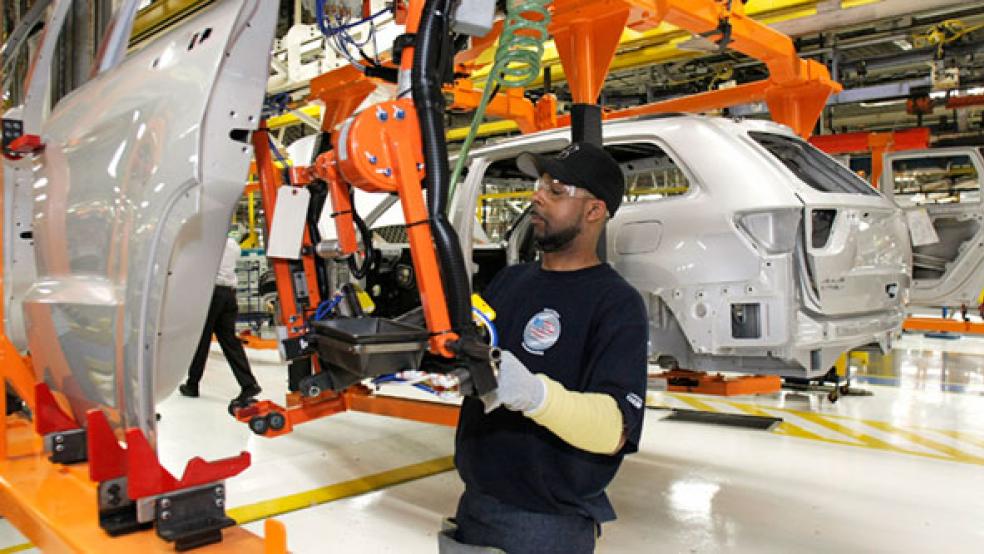A gauge of U.S. factory activity held near a 2-1/2-year high in December and the number of Americans filing new claims for jobless benefits fell for a second week last week, pointing to resilience in the economy. Other data on Thursday showed construction spending hit its highest level in nearly five years in November.
The Institute for Supply Management (ISM) said its index of national factory activity stood at 57.0 last month from November's 2-1/2-year high of 57.3. Readings above 50 indicate expansion. Still, December's result was the second highest reading in 2013.
Related: Nouriel Roubini: Less Doom and Gloom in 2014
"Sentiment is improving. This is all very positive. We are looking for growth to pick up once again in the new year," said Scott Brown, chief economist with Raymond James in St. Petersburg, Florida.
In a separate report, the Labor Department said initial claims for state unemployment benefits slipped 2,000 to a seasonally adjusted 339,000.
Though claims continue to be plagued by seasonal fluctuations, economists said last week's decline was consistent with an improvement in labor market conditions and was in line with other indicators showing an acceleration in job growth. A gauge of employment in the ISM survey touched its highest level since June 2011.
"Jobless claims remain at a level consistent with improving labor market conditions. We continue to expect a 215,000 increase in nonfarm payrolls for December," said Laura Rosner, a U.S. economist at BNP Paribas in New York.
Related: How the Right Corporate Culture Can Guarantee Success
Employers added 203,000 new jobs to their payrolls in November and the unemployment rate fell 0.3 percentage point to 7 percent. December non-farm payrolls data will be released on January 10, with the median of forecasts from analysts polled by Reuters calling for 193,000 new jobs last month.
Firing on All Cylinders
Against the backdrop of a firming jobs market and brightening economic outlook, the Federal Reserve in December announced it would reduce its monthly $85 billion bond buying program by $10 billion starting this month. That strengthening outlook was underscored by a third report from the Commerce Department showing construction spending increased 1 percent in November to an annual rate of $934.4 billion, the highest level since March 2009. It was the eighth straight month that construction spending increased.
From employment to consumer spending and industrial production, the economy is starting to fire on all cylinders even as growth is expected to step down from the third-quarter's brisk 4.1 percent annual rate. Construction spending in November was lifted by a jump in private construction projects to the highest level since December 2008. Private construction spending rose 2.2 percent after being flat in October.
Related: You Won't Believe How Much Richer Stock Investors Got in 2013
The increase reflected strong gains in spending on both residential and nonresidential projects. Private residential spending hit its highest level since June 2008 and outlays on nonresidential structures, which include factories and gas pipelines, touched an 11-month high. Public construction spending fell 1.8 percent as both outlays on federal and state and local government projects declined.
The jobless claims report showed the number of people still receiving benefits under regular state programs after an initial week of aid fell 98,000 to 2.83 million in the week ended December 21. A total of 4.46 million people were receiving benefits under all programs in the week ended Dec 14. But with benefits for more than a million long-term unemployed Americans having expired on December 28, that figure is set to fall sharply in the coming weeks.
The emergency unemployment compensation program was introduced in 2008 during the depths of recession, and had been extended every year since then. The loss of benefits could spur former recipients to either drop out of the labor force or accept jobs they previously would not have considered.
Some economists estimate this could lower the current unemployment rate of 7.0 percent by as much as half a percentage point. "We may see a notable impact on labor force participation in the January nonfarm payroll report," said Gennadiy Goldberg an economist at TD Securities in New York.
With additional reporting by Richard Leong and Steven C. Johnson in New York, both of Reuters.




